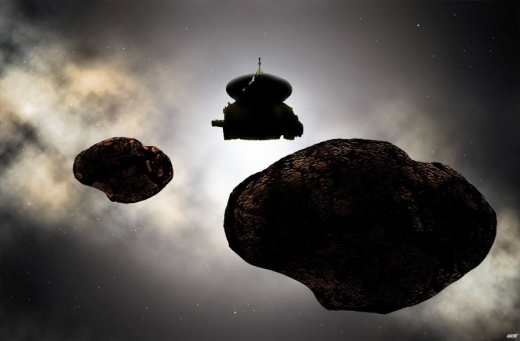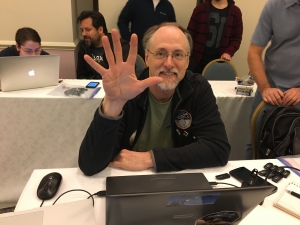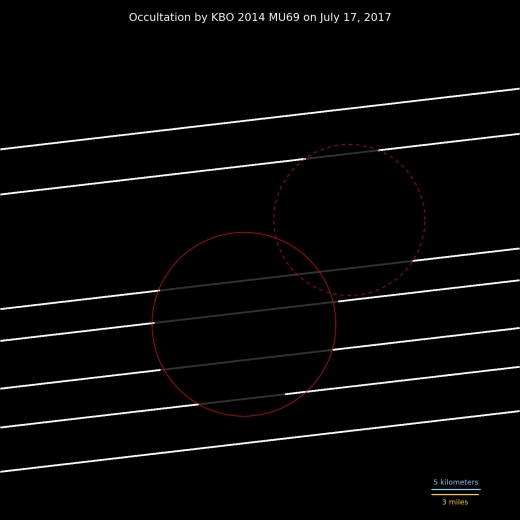Knowing that he was busy in Australia, I hadn’t thought that Alan Stern would get off a new report on New Horizons quite this fast (he wrote it over the Pacific on the flight back). But there’s enough here that I want to supplement this week’s earlier post about the three occultations of 2014 MU69, the distant Kuiper Belt Object toward which the spacecraft now moves at roughly a million kilometers a day. I’m also taken with an image in Stern’s latest, seen below. What we’re looking at is the spacecraft as it approaches what we now think may be a binary object, with the dense starfield in Sagittarius stretching out behind. Nice work by artist Carlos Hernandez.

Image: Artist’s concept of the New Horizons spacecraft flying by a possible binary MU69 on Jan. 1, 2019. Credit: Carlos Hernandez.
The three occultations observed in June and July were examined in particular for evidence of debris, rings or other hazards that could cripple the spacecraft during the close approach. The encounter speed will be in the neighborhood of 14.2 kilometers per second, making even tiny pebbles a potential mission-ender. The work, involving two dozen telescopes and including data from the airborne NASA SOFIA observatory, produced no show-stoppers by way of debris but did give us the information that MU69 may be not one but two objects in close proximity.
All this has interesting implications, as we discussed on Tuesday. Here’s how Stern described the findings of the occultation effort, which was led by science team co-investigator Marc Buie:

The result Buie and Co. found was surprising and spectacular and scientifically seductive: MU69 appears to be either a binary orbiting pair or a contact (stuck together) pair of nearly like-sized bodies with diameters near 20 and 18 kilometers… This means we are very likely going to a primordial binary in the Kuiper Belt, a 4-billion-year-old relic of solar system formation and an exotic building block of the small planets of the Kuiper Belt like Pluto, Ixion, Makemake, Sedna and Eris.
Image: Marc Buie, New Horizons occultation campaign lead, holds up five fingers to represent the number of mobile telescopes in Argentina initially believed to have detected the fleeting shadow of 2014 MU69. The New Horizons spacecraft will fly by the ancient Kuiper Belt object on Jan. 1, 2019. Credit: NASA/Johns Hopkins University Applied Physics Laboratory/Southwest Research Institute/ Adriana Ocampo.
We also learn several new things from Stern’s report, written on his way back from the Deep Space Network (DSN) communications station outside Canberra in New South Wales. Astronomer Susan Benecchi (Planetary Science Institute) led studies with the Hubble Space Telescope this summer to examine MU69 from the standpoint of variations in brightness as it rotates on its axis, which could be an early clue to its shape and features.
The brightness variation turns out to be less than 20 percent, which implies that the object is either spherical in shape, or else is being observed with its pole pointed toward Earth. Perhaps both are true, but the finding adds to the suspense of the MU69 encounter as we try to reconcile a close binary with the Hubble brightness results. Have a look at the image below.

Image: MU69’s shadow traces its most likely binary shape, as seen in the stellar occultation that occurred over Argentina on July 17, 2017. The best-fit red circles reveal MU69’s possible doubled-lobed – or binary – nature. Credit: NASA/JHUAPL/SwRI/Alex Parker.
The flyby, scheduled for January 1, 2019, has now been moved forward by about an hour, an adjustment that, according to Stern, optimizes the viewing angles from the Canberra and Goldstone (CA) stations of the Deep Space Network. The team hopes to maximize the odds for measuring MU69’s mass by exquisitely precise tracking of New Horizons during the flyby. There will also be a DSN attempt to illuminate the KBO to measure its radar reflectivity.
Currently in a five-month hibernation period, New Horizons will ‘awaken’ on September 11, at which point instrument tests and observations, along with routine spacecraft maintenance, can continue. An improved suite of fault protection software, the last such upload, will be sent in early October. Stern explains the game plan going forward:
This fall, after New Horizons emerges from hibernation, we’ll craft the MU69 flyby observation plan in exquisite detail. We’ll also make more science observations of distant KBOs, and we’ll be continuously measuring the Kuiper Belt’s radiation, dust and gas environment. Near the end of this year, on Dec. 9, we’ll fire our engines to trim our course to and optimize the arrival time at MU69 as I described earlier. Then New Horizons will enter hibernation one last time, before the MU69 flyby begins late next summer. New exploration awaits us, at the very frontier of our solar system – late in 2018 and early in 2019, both of which are almost around the corner!
And let me throw in congratulations to Marc Buie and his colleagues. Remember that we are dealing with an object that is seven billion kilometers out, and no more than 30 kilometers in diameter. Imagine the faintness of the shadow thrown by these distant eclipses and consider what an extraordinary effort went into retrieving the data. Buie has truly pushed occultation science to a new level.



Can any of the smart denizens herein explain something about the camera that made those images of Pluto, and for the next object? I am wondering particularly about the very low levels of available light? How are these exposures made when the sun is so distant?
Before New Horizons arrived, enterprising folks posted times on Earth near dusk where light levels here were similar to high noon on Pluto. Dark indeed.
And in fact recent photos released by Cassini of the rings close up made me wonder the same thing. In both cases, especially New Horizon, the speed of the instrument passing the object is a factor as well.
Is this an issue of very fast lenses, or?
Michael, I recall that Jim Bell’s book The Interstellar Age discussed this problem re Voyager; i.e., major differences in light levels the further out in the system the spacecraft traveled. On New Horizons specifically, and how its technology coped with light levels, let me see what I can dig up.
I wonder it New Horizons was launched with the following Voyager 2-tested in-flight upgrade “included as standard equipment”:
Before its Neptune system encounter, Voyager 2 was re-programmed to compensate for the dim sunlight by taking longer exposures (in a JPL booklet, the task was said to be like photographing coal on a dark night). To reduce or eliminate the “image smear” that longer exposures would cause due to the spacecraft’s motion through space, the attitude thruster control system was re-programmed to both rotate the spacecraft (to help keep its two vidicon slow-scan television cameras pointed squarely at their targets during exposures) and to prevent thruster-caused image blurring by making very short, low-impulse “blip” thruster firings. Also:
These upgrades made Voyager 2 a functionally “new” spacecraft, with capabilities that had not been envisioned when it was launched. (Pioneer 10 was also “electronically upgraded” in flight [although on the ground], when the flight controllers figured out how to keep its spin axis–and thus its high-gain antenna–pointed at Earth *without* having its automatic CONSCAN pointing system engage, which would have consumed more thruster propellant.) New Horizons may also have the capacity to be made a better, more capable spacecraft as it travels along, which might even–with a little “celestial mechanical luck”–make a third (or more?) Kuiper Belt Object flyby possible within the spacecraft’s thruster propellant budget.
Hello Michael,
Thanks, that’s a very important question (that’s why my answer will get a bit longer). You are absolutely right: Light level and the motion of the spacecraft need to be considered by the mission planners!
First, the instrument: The camera on NH is called LORRI. It’s a sensitive CCD camera connected to an 8-inch telescope. That camera is much more sensitive than, say, the camera in your smartphone. In fact it is so sensitive that it would be damaged if it were used at daylight brightness level on Earth.
For more details about LORRI and the other instruments, see the Wikipedia article (https://en.wikipedia.org/wiki/New_Horizons#Long-Range_Reconnaissance_Imager_.28LORRI.29).
Then there’s the light level at Pluto (or at 2014 MU69; that doesn’t make much difference). High noon at Pluto is like twilight on Earth. But that’s actually quite bright! Yes, the Sun is 1,000 times fainter than from Earth, but that’s still 400 times brighter than the full Moon. And even the full Moon is bright enough to cast shadows on Earth. You can take photos at twilight even with a phone camera. LORRI can handle that!
But there are still issues, and every sensor has its limits: If the surface is too dark (not because of a lack of light, but because it has a dark color), you need a longer exposure to collect enough photons. A longer exposure means that you risk smearing if the spacecraft is moving and/or the target is very close. That can be challenging!
Most of the photos of Pluto were taken with exposure times between 60 and 150 milliseconds. But for the closest images, that would have been too long, and they were taken with 10 ms (1/100th of a second). That’s why some of them look more noisy than the photos taken from further out (example: http://pluto.jhuapl.edu/soc/Pluto-Encounter/data/pluto/level2/lor/jpeg/029917/lor_0299179685_0x636_sci_2.jpg). But with the right processing, most of the noise can be removed and the image brightness can be adjusted (see http://pluto.jhuapl.edu/Multimedia/Science-Photos/pics/Very-best-view-of-Pluto-(mosaic).jpg for a processed version of that same data).
For Pluto, surface brightness was known in advance (from Earth based observations), and it was clear that 10 ms exposures would still be okay. For 2014 MU69, that’s not immediately clear: The size of the object was unknown until last week, and it was possible that it could have a very dark surface. That would have set strong constraints on the closest distance from where you could take a sharp photo. But now we know how large 2014 MU69 is (roughly 30 by 20 km), and that corresponds to a surface brightness similar to that of Earth’s moon (an albedo of about 0.11).
With that information, the mission planners will be able to accurately plan the encounter, such that we get the best possible images.
As a side note: The problem of smearing is why it’s not always good to be too close to the target, and why it makes no sense to get closer than a few thousand km to any object New Horizons wants to image.
Cheers,
Daniel
Excellent, Daniel. Thanks for illuminating this issue. And thanks to Jason, too, for the Voyager insights.
Ah, just what I wanted— a reply from an actual expert, and much appreciated. I don’t think I realized just how ‘light’— meaning ‘not so dark’— the environment out there really is; “400 times brighter than the full moon” is quite vivid. Brighter than I imagined.
And I wondered, too, about the accuracy involved when rotating the spacecraft in order to avoid smearing, not realizing just how accurate the rotation can be.
Thank you.
The pointing is very accurate! New Horizons has a star map on its computer. It uses small cameras that observe the stars and compare with that map, to keep track of its orientation. You could say it navigates by the stars (it’s how most spaceprobes keep track of their orientation). It then uses small thrusters that can rotate the spacecraft in all three axes.
Hi Daniel,
Just a comment on the brightness of full moonlight. Using your albedo figure and doing a simple geometric calc I get that moonlight should be just under 1.8 million times dimmer than sunlight. Now I know that the albedo of the moon effectively changes with angle and increases near full moon due to small spherical particles on the surface of the moon that tend to reflect sunlight directly back. Does that explain the difference between my number and yours (i.e. 400 x 1000 = 400 000 rather than 1 800 000 ) or is it all rounding errors?
Cheers,
Philip
@Philip: The difference in brightness is best calculated from the apparent magnitudes (-12.7 mag vs. -26.7 mag, so the Sun is 14 mag brighter than the Moon) : 10^(0.4*14)=398,000.
There are three things that could contribute to the difference (400,000 vs. 1.8 million):
The Moon’s albedo is 0.12 (which is very similar, but not equal, to the 0.11 calculated for 2014 MU69). A diffuse sphere only reflects 2/3 as much light as a perfectly reflecting one (which you may have assumed). And the full Moon has a significant opposition effect of about 0.4 mag (a factor of 1.45 in brightness!). All together give a factor of 0.12/0.11*3/2*1.45=2.37. That brings you from 400,000 to 950,000. Still not enough to explain a value of 1.8 million.
Check your calculation (there may be an error).
@Michael Spencer: The pointing is very accurate! New Horizons has a star map on its computer. It uses small cameras that observe the stars and compare with that map, to keep track of its orientation. You could say it navigates by the stars (it’s how most spaceprobes keep track of their orientation). It then uses small thrusters that can rotate the spacecraft in all three axes.
In his “New Guide to the Moon,” Patrick Moore wrote that sunlight is half a million times brighter than moonlight.
Here is a detailed description of the LORRI camera/telescope to back up Daniel’s answer:
http://www.boulder.swri.edu/pkb/ssr/ssr-lorri.pdf
LORRI was designed to go quite deep:
LORRI has a 4×4 pixel binning mode, for which its limiting magnitude requirement is V>17 in a single exposure of 9.9 s. This 4×4 pixel-binning mode will be used to search for the target KBO and to perform optical
navigation on approach. A special spacecraft guidance mode is available for the KBO search in which the spacecraft will hold the target within the 4×4 pixel pointing tolerance for 10 second exposures. At 40 AU from the Sun, LORRI is predicted to be able to detect a 50 km diameter object, of albedo 0.04 and at phase angle 25°, from a distance of 0.35 AU, more than 40 days before the object would be encountered. This is ample time for targeting of the spacecraft.
My money goes on a contact binary.
Paul
Minor correction. Canberra and the deep space network are in the ACT (Australian Capital Territory) not the state of New South Wales, the same way Washington is in DC.
Could contact binaries be the norm for these objects and could this part of the reason that most comets have a similar shape? The dynamics of close binaries could also cause these objects to become comets and enter the solar system where the gas giants kick them into elliptical orbits that enter the inner solar system. (Example is the Jupiter comet families) Just how much energy would be available to change there orbits if a slow collision takes place over time, could there be outgasing of material? What could effect the orbit of two objects in the deep freeze and empty space beyond Pluto? Instead of passing stars causing the comets could this method be producing them?
So, how big of telescopes does it require to do this sort of transit imaging of small Kuiper objects? It says “mobile”, so I assume not huge.
Would it be feasible to launch a constellation of small telescopes specifically for the purpose of transit imaging small bodies?
IIRC, just normal 10, 15 inch ones, as long as they can see the occluded star easily, not MU69 itself.
That was my impression. I wonder how many of these objects we’d detect, if we went to the trouble of setting up a serious array of dedicated scopes?
The New Horizons team bought 24 small telescopes to distribute to local astronomers for their occultations =- a very wise allocation of resources imo. It doesn’t take a lot when the background star is sufficiently bright. The trouble is predicting where the occultor is going to be relative to the star and the ground, which is where the number of telescopes becomes critical.
Just a little fun with math. An object 1 miles in diameter about 11.8 billions miles distant would produce a “stellar eclipse” for a star that is about 1000 light years distant and a diameter of about 500,000 miles.
Although there are many assumptions in the above, it does give an idea of the resolving power of the technique.
You cannot forget about diffraction – the Fresnel size is ~ sqrt(Lambda * D), where D is the distance to the occultor and Lambda the observing wavelength. At 11.8 billion miles or 19 billion km (or 125 AU) the Fresnel length at 0.5 microns (visible light) is ~3 km or 2 miles – so an object 1 mile across wouldn’t produce a clean occultation, but a diffraction pattern. These are harder to detect, but can also provide information about distance, if you can follow the fringes.
Beyond my expertise but very interesting. Thanks.
That’s how Hubble detected the smallest known KBO (less than 1 km in size). It was seen in a brief occultation in the star trackers; the distance was calculated by the diffraction pattern; the size was then calculated by distance and duration of the event.